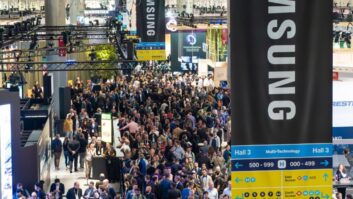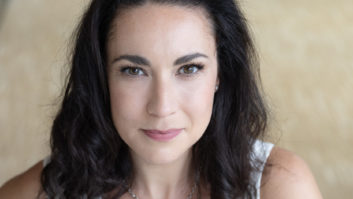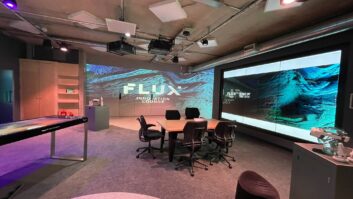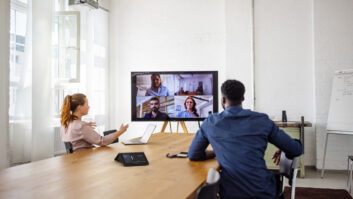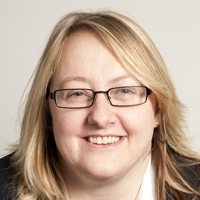
Founded in 1987, by 2008, Steljes had sold its 300,000th projector. The next year, the company sold its 300,000th SMART IWB. It’s clear that, historically, the company has done very well. Ian McMurray talked to Martine Dodwell-Bennett, who joined Steljes from RM six years ago and is now sales and marketing director, about how the company has succeeded – and how it plans to maintain that success.
How has your strategy changed over the past few years?
It really hasn’t – although we’ve got better on execution. Steljes has always worked on the principle that we should represent products that can really make a difference to end users – that can help them be more efficient, more competitive, more profitable. If we do that, we know that our channel will succeed – and, most importantly, make money from those products.
One of the things that makes Steljes unique is the amount of time, effort and money we put into market development – to create demand for the channel. That means a very high degree of engagement with the market and with end users.
What we achieved with SMART is an excellent example. That didn’t just happen overnight. The sales we’ve made are as a result of spending a great deal of time, working out the applications, identifying the right market, interacting with potential end users and so on. Only after that investment did we start to see adoption on the scale that we have after we had, in effect, created a category. Creating a category in that way is something we don’t see other distributors doing.
And, in fact, having effectively created the education market for interactive white boards in the UK, we were able to take what we’d learned and apply it to the corporate market – which is why we’re seeing widescale uptake of IWBs in that sector. Those customers see that it works, and see how it’s beneficial for their business. If you can do that, you’re likely to succeed.
We use a very similar business model in other areas – and we’ll continue to do so. Take 3D, for example. Everyone’s talking about it – but most of the sales the market is seeing are really no more than organisations ‘future-proofing’ their purchases, making sure that what they’ve got is 3D-ready so that they’re prepared for what the future might bring.
What end users want is a solution, not a technology. That means an infrastructure of support – like content, for example, which is why we’re working with 3D content providers among others. We’re very active in trying to prove that the concept is beneficial, and to ensure that it’s easy for the end user. That applies to 3D just as it did – does – to SMART boards.
Of course, it doesn’t always work – but Steljes’ success comes from backing more winners than losers.
The important thing is, it’s our channel that benefits. Yes, of course, we benefit – but central to our thinking is our understanding of the importance of our channel. 100% of our sales go through the channel – there’s no cherry picking.
How do you characterise your relationship with your channel?
It has to be based on trust. Our channel know that they can come to us with help on just about anything. They have use of any one of our four demonstration facilities in the UK. We’ll do demonstrations with them. We’ll provide pre-sales technical support. If the end user needs some kind of proof of concept, or a pilot study – we can do that.
I think they appreciate what we’re able to do for them. But it’s not just about us developing markets that they can serve profitably. We also need to be responsive to the demand they’re seeing. You could say that our strategy is a combination of market development on the one hand, and market responsiveness on the other hand. In fact, it tends to be somewhat cyclical: we’ll spend a period of time developing the market, and then a period of time responding to market demand that we’ve created.
Take projectors, for example. For the most part, there’s little we can do to develop the mainstream projector market, as it’s pretty mature – but projectors are a staple of the business and our channel needs to be able to fulfil the demand that exists. They look to us to help them do that. They need to be able to offer a choice – and we need to provide them with it. It’s the same with visualisers.
That said: we’re back into the market development stage on projection on the 3D side, though. That’s why I say it’s cyclical.
Of course, it’s also important that we see the ranges we carry as complementary, and not eating into sales we would have made anyway. That’s why, when we add a brand, we are comfortable that we aren’t just cannibalising our existing vendors’ volume. It has to be incremental business both for the new vendor and for Steljes.
So what does it take for you to work with a projector manufacturer, for example?
The underlying principle – and it applies as much here as it does to what we do in terms of market development – is that we have to see the same opportunity as our vendors, be committed to the same things. When two organisations are in line with each other, it just works.
For example, we recently took on BenQ again, having parted company with them a while back. They came back to us with a very good product line-up, backed by a good service and support package. But more importantly, BenQ had clear aspirations about what they wanted to achieve – and we felt we could help them achieve those aspirations.
It was the same with Hitachi. A robust, competitive offering of products and support backed by a solid brand is just a starting point. What they were looking to do was in line with what we were looking to do, and there was a real commitment to partnership – something that’s important throughout our business.
Can you explain your European strategy?
Our strategy in Europe is a very controlled, very well-defined one. We’re not about replicating Steljes in the UK in other countries. Rather, our European strategy is primarily about supporting business – supporting customers – on a more local basis. If you take some of the major organisations we’ve established relationships with in the UK, for example, many of them are looking to use their SMART-based solutions to collaborate from country to country. With BT, for example, it’s from Ipswich to India. There’s another comes to mind who want to communicate between their offices in Hungary, New York and London. They want local support.
So, typically, we’re not looking to generate new business from outside the UK. The only exception to that is with Mainline, our track-based mains power solution. That is a market we’re looking to develop in other countries.
What do you see as the challenges of the next few years?
There’s an extent to which the main challenge of the next few years is the same challenge we’ve faced for the last few years. Technology doesn’t stand still – and we need to continue to ensure that we’re backing the right ones.
Something that’s easily overlooked is the challenge of recruiting, developing and retaining the right people. For a distributor, Steljes is a relatively people-intensive business – because of the way we work, because of the way we develop the market and engage with customers. We have eight people out there on corporate business development, and seven working in the education market, for example. Those need to be – and are – top quality people if our business is to thrive.
I think the third challenge is the economy, and what that does to budgets. If we’re not careful, our channel will struggle. We need to ensure we’re supportive, that we come up with creative rental and leasing propositions that our channel can offer to their customers to make buying decisions easier. There are other things we’re doing, and will continue to do, to try to mitigate the difficulties our channel faces. Education, for example, is an uncertain market today – although the corporate market is doing rather better, because those businesses can see the ROI, see how a solution can save them money – sometimes within as little as three months. We’ll be helping our channel make the most of both the difficult markets and the markets where there’s still good growth.


